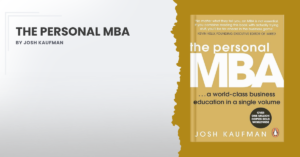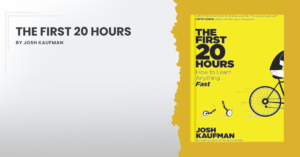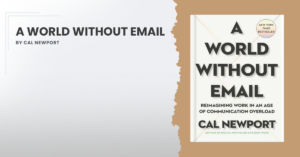Title: The 4-hour Workweek: Escape 9-5, Live Anywhere, and Join the New Rich
Author: Tim Ferriss
Year: 2009
Pages: 396
Tim Ferriss, in his groundbreaking book The 4-Hour Workweek, takes readers on a journey from the conventional 9-to-5 grind to a life of unconventional freedom and efficiency.
Ferriss challenges societal norms, urging readers to question the traditional concept of work and embrace a paradigm shift that prioritizes time and experiences over endless toil.
The book provides a blueprint for crafting a life that revolves around one’s passions, rather than being confined by the constraints of a traditional work week.
As a result, I gave this book a rating of 9.0/10.
For me, a book with a note 10 is one I consider reading again every year. Among the books I rank with 10, for example, is Dale Carnegie’s How to Win Friends and Influence People.
3 Reasons to read The 4-Hour Workweek
Efficiency in Fitness
Ferriss unveils time-efficient strategies to achieve remarkable fitness results. With his minimalist approach, readers can ditch marathon workouts for shorter, more impactful sessions.
Health Optimization
The book delves into unconventional but scientifically grounded methods for enhancing health, from sleep improvement to testosterone manipulation, offering readers a roadmap to peak vitality.
Personal Transformation
Ferriss doesn’t just focus on physical changes. The book explores psychological and behavioural shifts, guiding readers on how to cultivate discipline and resilience for a holistic transformation.
Book Overview
The 4-Hour Workweek by Tim Ferriss is a groundbreaking exploration of how individuals can liberate themselves from the conventional constraints of a 9-to-5 work life and embrace a new paradigm of efficiency and freedom.
Ferriss challenges the traditional concept of retirement and advocates for the pursuit of ‘mini-retirements’ throughout life, encouraging readers to prioritize experiences over possessions.
The 4-Hour Workweek introduces the concept of the “New Rich,” individuals who prioritize time and fulfilment, creating a mindset that values mobility and intentional living.
At its core, the book delves into practical strategies for optimizing time and achieving more with less effort. Ferriss introduces the 80/20 principle, guiding readers to identify and focus on the tasks that yield the most significant results.
The exploration of outsourcing and automation provides insights into delegating non-essential tasks, allowing individuals to reclaim valuable time and redirect it towards activities that align with their passions.
By advocating for remote work opportunities and the creation of automated income streams, Ferriss empowers readers to design a life that not only meets financial goals but also enhances overall well-being.
The 4-Hour Workweek is more than just a career guide; it’s a manifesto for lifestyle design.
Tim Ferriss shares personal anecdotes and case studies, illustrating how individuals can break free from societal expectations and cultivate a life of purpose, adventure, and continuous improvement.
The 4-Hour Workweek is a blend of unconventional wisdom, practical advice, and a call to challenge the status quo.
What are the Key Ideas
Leveraging the 80/20 Principle
Ferriss introduces the 80/20 principle, emphasizing that 80% of results come from 20% of efforts. He guides readers on identifying and focusing on the most impactful tasks to achieve maximum efficiency.
Mini-Retirements
Ferriss challenges the conventional concept of retirement, proposing the idea of taking “mini-retirements” throughout life to enjoy experiences and adventures when they matter most.
Automated Income Streams
The author explores various methods of creating passive income streams, providing financial independence and freeing up time for more meaningful pursuits.
The New Rich Mindset
Ferriss introduces the concept of the “New Rich” – individuals who prioritize time and experiences over traditional wealth, fostering a mindset that values mobility and fulfilment.
What are the Main Lessons
My Book Highlights
For all of the most important things, the timing always sucks. Waiting for a good time to quit your job? The stars will never align and the traffic lights of life will never all be green at the same time. The universe doesn’t conspire against you, but it doesn’t go out of its way to line up the pins either. Conditions are never perfect. “Someday” is a disease that will take your dreams to the grave with you. Pro and con lists are just as bad. If it’s important to you and you want to do it “eventually,” just do it and correct course along the way
What we fear doing most is usually what we most need to do
People will choose unhappiness over uncertainty
But you are the average of the five people you associate with most, so do not underestimate the effects of your pessimistic, unambitious, or disorganized friends. If someone isn’t making you stronger, they’re making you weaker
A person’s success in life can usually be measured by the number of uncomfortable conversations he or she is willing to have
If you are insecure, guess what? The rest of the world is, too. Do not overestimate the competition and underestimate yourself. You are better than you think
The question you should be asking isn’t, “What do I want?” or “What are my goals?” but “What would excite me?
Focus on being productive instead of busy
The opposite of love is indifference, and the opposite of happiness is boredom
To enjoy life, you don’t need fancy nonsense, but you do need to control your time and realize that most things just aren’t as serious as you make them out to be
Most people are fast to stop you before you get started but hesitate to get in the way if you’re moving
There is less competition for bigger goals
In conclusion, The 4-Hour Workweek is a transformative guide that challenges the conventional narrative of work and life, urging readers to redefine success on their own terms.
The 4-Hour Workweek provides a roadmap to escape the constraints of a traditional workweek, emphasizing the value of time, experiences, and intentional living.
By introducing practical strategies like the 80/20 principle, outsourcing, and automation, Ferriss empowers individuals to optimize their efforts and focus on what truly matters.
The book’s emphasis on the “New Rich” mindset, mini-retirements, and the pursuit of meaningful experiences elevates it beyond a mere career manual, making it a manifesto for those seeking a life of purpose, fulfilment, and continuous improvement.
The 4-Hour Workweek is an invitation to challenge the status quo, design a life by intention, and embark on a journey toward a more liberated and fulfilling existence.
I am incredibly grateful that you have taken the time to read this post.
Do you want to explore more?
Check my main categories of content below:
- Agile
- Blog
- Book Notes
- Career
- Leadership
- Management
- Managing Yourself
- Productivity
- Project Management
- Technology
- Weekly Pulse
Navigate between the many topics covered in this website:
Agile Art Artificial Intelligence Blockchain Books Business Business Tales Career Coaching Communication Creativity Culture Cybersecurity Design DevOps Economy Emotional Intelligence Feedback Flow Focus Gaming Goals GPT Habits Health History Innovation Kanban Leadership Lean Life Managament Management Mentorship Metaverse Metrics Mindset Minimalism Motivation Negotiation Networking Neuroscience NFT Ownership Parenting Planning PMBOK PMI Politics Productivity Products Project Management Projects Pulse Readings Routines Scrum Self-Improvement Self-Management Sleep Startups Strategy Team Building Technology Time Management Volunteering Work
Do you want to check previous Book Notes? Check these from the last couple of weeks:
- Book Notes #124: Radical Candor by Kim Scott
- Book Notes #123: The Personal MBA by Josh Kaufman
- Book Notes #122: The First 20 Hours by Josh Kaufman
- Book Notes #121: A World Without Email by Cal Newport
- Book Notes #120: Storynomics by Robert McKee and Thomas Gerace
Support my work by sharing my content with your network using the sharing buttons below.
Want to show your support tangibly? A virtual coffee is a small but nice way to show your appreciation and give me the extra energy to keep crafting valuable content! Pay me a coffee:




